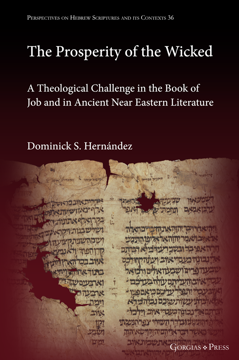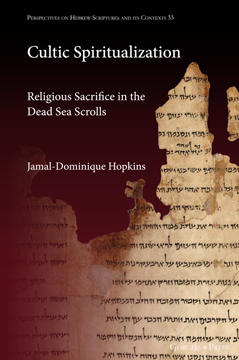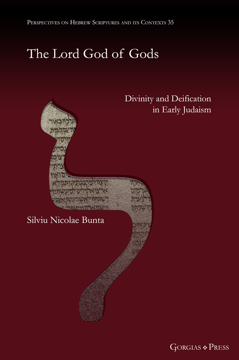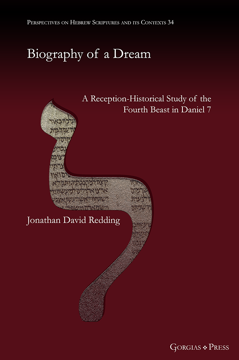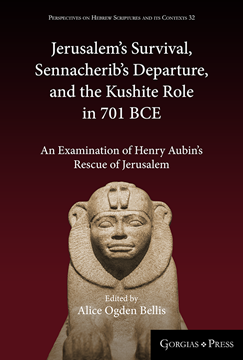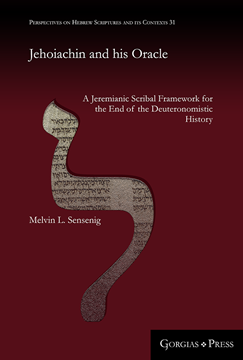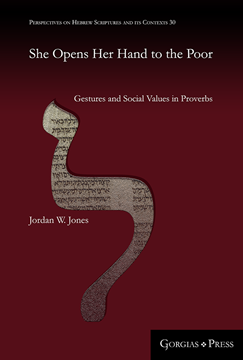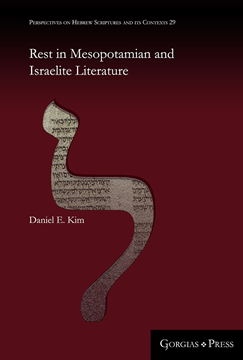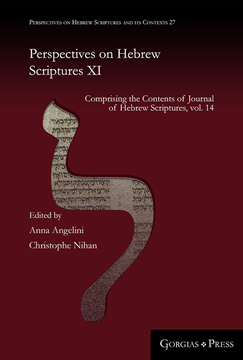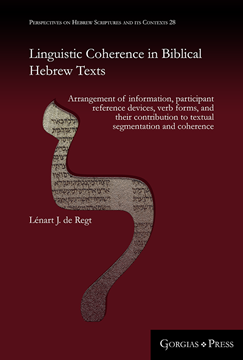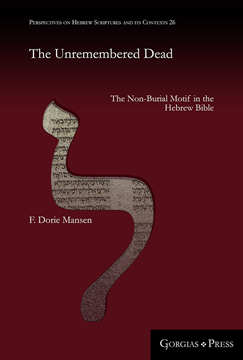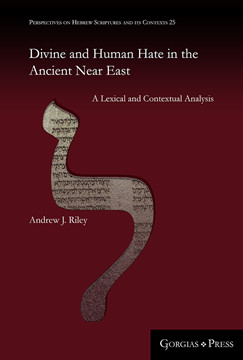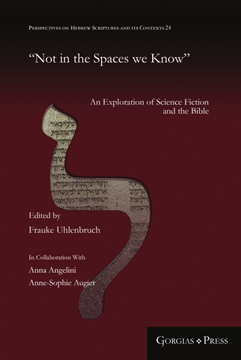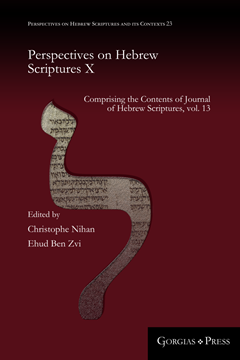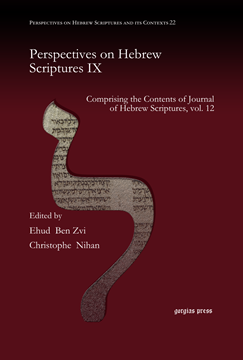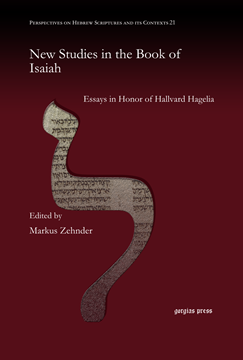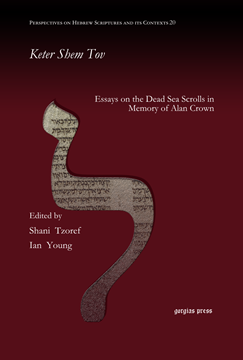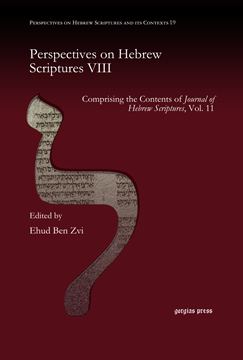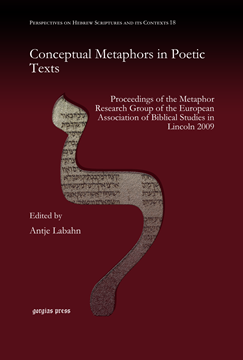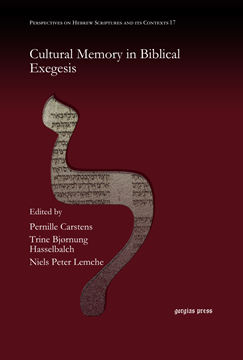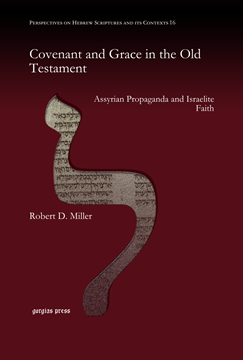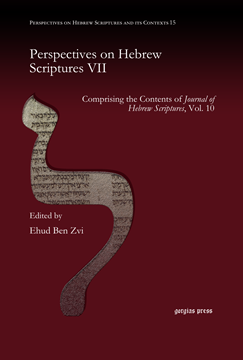Recently viewed products
Perspectives on Hebrew Scriptures and its Contexts
This series contains volumes dealing with the study of the Hebrew Bible, ancient Israelite society and related ancient societies, Biblical Hebrew and cognate languages, the reception of biblical texts through the centuries, and the history of the discipline. The series includes monographs, edited collections, and the printed version of the Journal of Hebrew Scriptures.
The Prosperity of the Wicked (paperback)
A Theological Challenge in the Book of Job and in Ancient Near Eastern Literature
ISBN: 978-1-4632-4822-2
Does Job convincingly argue against a fixed system of just retribution by proclaiming the prosperity of the wicked—an assertion that distinctly runs contrary to traditional biblical and ancient Near Eastern wisdom? This study addresses this question, giving careful consideration to the rhetoric, imagery, and literary devices used to treat the issue of the fate of the wicked in Job’s first two rounds of dialogue, where the topic is predominantly disputed. The analysis will glean from related biblical and non-biblical texts in order to expose how Job deals with this fascinating subject and reveal the grandeur of the composition.
$75.00 (USD) $60.00 (USD)
Between the Lines
The Literary and Ideological Shaping of Judah’s Genealogies in Chronicles
ISBN: 978-1-4632-4813-0
The book of Chronicles has received a revival in recent scholarship, making it one of the most studied books, and this is especially true from 1 Chronicles 10 onwards—ignoring the genealogies of 1 Chronicles 1-9. Yet, when the Chronicler incorporated these lists into his book, he designed them with a deliberate and sophisticated literary design according to his purposes. In “And the Records are Ancient,” Klein exposes these designs in all their glory and shows the great richness inherent in seemingly boring texts.
$114.95 (USD) $91.96 (USD)
The Book of Samuel
Studies in History, Historiography, Theology and Poetics Combined
ISBN: 978-1-4632-4501-6
An inter-disciplinary study of the story and history of Israel's transition from tribal federation to monarchy, covering the events described in 1 Samuel 1–16; 2 Samuel 21–24; and 1 Kings 1–4. It follows the 2018 publication of The Book of Samuel: Part One, Studies in History, Historiography, Theology, and Poetics Combined (Jerusalem: Rubin Mass).
$95.00 (USD) $76.00 (USD)
The Prosperity of the Wicked
A Theological Challenge in the Book of Job and in Ancient Near Eastern Literature
ISBN: 978-1-4632-4424-8
Does Job convincingly argue against a fixed system of just retribution by proclaiming the prosperity of the wicked—an assertion that distinctly runs contrary to traditional biblical and ancient Near Eastern wisdom? This study addresses this question, giving careful consideration to the rhetoric, imagery, and literary devices used to treat the issue of the fate of the wicked in Job’s first two rounds of dialogue, where the topic is predominantly disputed. The analysis will glean from related biblical and non-biblical texts in order to expose how Job deals with this fascinating subject and reveal the grandeur of the composition.
$114.95 (USD)
Cultic Spiritualization
Religious Sacrifice in the Dead Sea Scrolls
ISBN: 978-1-4632-4241-1
Throughout the history of research on the Dead Sea Scrolls, the investigation of religious sacrifice has been neglected. This book examines the views of sacrifice in the non-biblical sectarian Dead Sea Scrolls, through exploration of the historical and ideological development of the movement related to the scrolls (the DSS movement), particularly from the vantagepoint of the movement's later offshoot group known as the Qumran community
$110.95 (USD)
The Lord God of Gods
Divinity and Deification in Early Judaism
ISBN: 978-1-4632-4333-3
The investigation of this book into early Jewish experiences of God begins with calls to discard any categorical and definitional approaches to the literature of early Judaism, and several enduring preconceptions about its mysticism and theology (particularly the relegation of its mysticism to particular texts and themes, and the molding of its theology in the image of medieval and post-medieval Jewish and Christian monotheisms). With this abandonment, the symbolic language of early Jewish texts gives sharper contours to a pre-formal theology, a theology in which God and divinity are more subjects of experience and recognition than of propositions. This clarity leads the investigation to the conclusion that early Judaism is thoroughly mystical and experiences a theology which is neither polytheistic, nor monotheistic, but deificational: there is only one divine selfhood, the divinity of “God,” but he shares his selfhood with “gods,” to varying degrees and always at his discretion. With some important differentiations which are also introduced here, this theology undergirds almost the entirety of early Judaism—the Bible, post-biblical texts, and even classical rabbinic literature. The greatest development over time is only that the boundaries between God and gods become at once clearer and less rigid.
$114.95 (USD)
Biography of a Dream
A Reception-Historical Study of the Fourth Beast in Daniel 7
ISBN: 978-1-4632-4243-5
The biblical apocalyptic books of Daniel and Revelation are, for better or worse, polarizing. Interpreters have long read and searched these books for clues about how their worlds will “end,” which each new interpreter promising to have “unlocked” how Daniel and Revelation work together to uncover a divine plan for prophetic fulfillment. Redding uses the Vision of the Fourth Beast from Daniel 7 as a case study to consider how interpretations of texts take on lives of their own, eventually wedding interpretation with text and prompting the question: what even is a text? Is it what is on the page, something interpreters put there, or a combination of both? Starting with the literature of the Levant, this work traces the use of motifs, images, and themes through Daniel, Revelation, and into pre-Enlightenment Christian thinkers to consider hermeneutical trajectories that shaped (and continue to shape) how modern readers engage biblical apocalyptic literature.
$114.95 (USD)
Jerusalem's Survival, Sennacherib's Departure, and the Kushite Role in 701 BCE
An Examination of Henry Aubin's Rescue of Jerusalem
Edited by Alice Ogden Bellis
ISBN: 978-1-4632-4156-8
In 2002 Henry T. Aubin published The Rescue of Jerusalem: The Alliance Between Hebrews and Africans in 701 BC. Aubin, an award-winning Canadian journalist, explores Jerusalem’s survival in 701 BCE in the face of an Assyrian invasion of the Levant. It is unusual for a book in biblical studies to be reconsidered fifteen to twenty years later. The rationale for a book-length collection devoted to Aubin’s The Rescue of Jerusalem is, first of all, the importance of the issues it raises for the academy and beyond. This volume brings together excellent scholars from several fields to consider certain issues that are raised by The Rescue of Jerusalem’s thesis that an army of Egypt’s Twenty-fifth Dynasty was influential in saving Jerusalem from destruction; the dynasty was composed of Kushites, who came from present-day Sudan. This volume is important for another reason. Not only does The Rescue of Jerusalem raise issues regarding what may have happened in 701 BCE; it also probes Western biblical scholarly attitudes regarding the Twenty-fifth Dynasty’s involvement in those events. Aubin's approach raises important concerns about scholarly attitudes, not only from the past, but also about the ways in which past attitudes have a way of continuing to color later academic discourse when they are not challenged. Cover image: Taharqo, the Kushite commander of expeditionary force of 701 BCE and later Pharaoh of Egypt’s Twenty-fifth Dynasty
$141.00 (USD)
Jehoiachin and his Oracle
A Jeremianic Scribal Framework for the End of the Deuteronomistic History
ISBN: 978-1-4632-4043-1
King Jehoiachin, the last Judahite king exiled to Babylon, became the focus of conflicting hopes and fears about a revived Davidic kingship after the exile. As Sensenig demonstrates, this conflict stemmed from a drastic oracle from Jeremiah that seemed to categorically reject Jehoiachin, while the canon records that he not only survived but thrived in exile.
$114.95 (USD)
She Opens Her Hand to the Poor
Gestures and Social Values in Proverbs
ISBN: 978-1-4632-4045-5
While scholarship on nonverbal communication in the Hebrew Bible has traditionally focused on ritual dress, postures of worship, and related topics, there exist a number of non-ritual gestures in the text for which we have little understanding, such as occur in the book of Proverbs. As the premier source for moral pedagogy in the Hebrew Bible, Proverbs contains a number of gestures that, when properly interpreted, enhance an understanding of social values in ancient Israel. To aid in the process of decoding these literary features, Jones examines Ugaritic, Akkadian, Egyptian, and Sumerian texts, identifying similar gestures and anatomical idioms and how they are variously interpreted in their respective contexts. Though the particular religious and cultural systems of these neighboring entities are distinct, their ideology of social values—values imbedded in the fabric of daily life and indicative of the universally shared experience of all communities—comes to the fore through the medium of gesture.
$114.95 (USD)
Rest in Mesopotamian and Israelite Literature
ISBN: 978-1-4632-0709-0
Rest in Mesopotamian and Israelite Literature studies the concept of rest in the Hebrew Bible and ancient Near Eastern literature. Through close examination of Mesopotamian texts and selections from the Deuteronomistic History and Chronicles, Kim delineates a concept of rest for each body of literature, and employs a comparative approach to illuminate the rest motif in the Hebrew Bible in light of Mesopotamian literature.
$114.95 (USD)
Perspectives on Hebrew Scriptures XI
Comprising the Contents of Journal of Hebrew Scriptures, vol. 14
Edited by Christophe Nihan & Anna Angelini
ISBN: 978-1-4632-0749-6
This volume incorporates all the articles and reviews published in volume 14 (2014) of the Journal of Hebrew Scriptures.
$198.00 (USD)
Linguistic Coherence in Biblical Hebrew Texts
Arrangement of information, participant reference devices, verb forms, and their contribution to textual segmentation and coherence
ISBN: 978-1-4632-3938-1
This monograph explores the distinct ways in which four discourse devices participate in establishing coherence in Biblical Hebrew texts. Bringing together linguistics, literary analysis, pragmatics, and translation methodology, de Regt demonstrates how a thorough understanding of the functions of devices of linguistic coherence beyond the sentence level should be integrated into biblical translation methodology and Biblical Hebrew pedagogy.
$114.95 (USD)
The Unremembered Dead
The Non-Burial Motif in the Hebrew Bible
ISBN: 978-1-4632-0696-3
The Unremembered Dead examines the motif of non-burial in the Hebrew Bible in its ancient Near Eastern contexts. Mansen proposes a new typology for analyzing these references, and demonstrates the range of functions that the non-burial motif served as a literary weapon in both biblical and extra-biblical texts.
$145.20 (USD)
Divine and Human Hate in the Ancient Near East
A Lexical and Contextual Analysis
ISBN: 978-1-4632-0695-6
Divine and Human Hate in the Ancient Near East studies lexemes for ‘hate’ in Biblical Hebrew, Ugaritic, and Akkadian. Riley conducts a lexical study of three ‘hate’ terms, along with comparative analysis of divine and human hate in biblical, Ugaritic, and Mesopotamian literature.
$123.00 (USD)
"Not in the Spaces we Know"
An Exploration of Science Fiction and the Bible
ISBN: 978-1-4632-0694-9
This volume explores themes at the intersection of the Bible and science fiction. In the genre of science fiction in film, books, comic books, or fan fiction, we find portrayals of possible futures, altered pasts, supernatural or beyond-human beings. Just as in biblical literature, science fiction can contain metaphysical speculation. Departing from this intersection, the authors engage with biblical texts 'as' science fiction, asking different questions of their sources: can science fiction theory and practice yield new approaches to the discussion of biblical texts? The authors reflect on methodology and offer case studies that include, among others, superhuman biblical kings and uncanny divine intermediaries.
$117.00 (USD)
Perspectives on Hebrew Scriptures X
Comprising the Contents of Journal of Hebrew Scriptures, vol. 13
Edited by Christophe Nihan & Ehud Ben Zvi
ISBN: 978-1-4632-0691-8
This volume incorporates all the articles and reviews published in volume 13 (2013) of the Journal of Hebrew Scriptures.
$251.00 (USD)
Perspectives on Hebrew Scriptures IX
Comprising the Contents of Journal of Hebrew Scriptures, vol. 12
Edited by Ehud Ben Zvi & Christophe Nihan
ISBN: 978-1-4632-0420-4
This volume incorporates all the articles and reviews published in volume 12 (2012) of the Journal of Hebrew Scriptures.
$287.00 (USD)
New Studies in the Book of Isaiah
Essays in Honor of Hallvard Hagelia
Edited by Markus Zehnder
ISBN: 978-1-4632-0356-6
This volume contains twelve articles that shed new light on the Book of Isaiah, covering a wide array of historical, linguistic and theological topics. The various aspects of God’s intervention at different points of human history is a main focus of the studies. The collection is marked by a broad diversity in approaches and theological background, and is a useful tool especially for scholars, students and pastors.
$157.00 (USD)
Keter Shem Tov
Essays on the Dead Sea Scrolls in Memory of Alan Crown
Edited by Shani Tzoref & Ian Young
ISBN: 978-1-61143-866-6
This eclectic collection contains 16 articles on a variety of topics within Qumran Studies from a conference held in memory of the late Professor Alan Crown. Essays cover the impact of the Qumran discoveries on the study of the Hebrew Bible and the New Testament to the study of the scrolls themselves and the community organizations presupposed in them, focusing as well on topics as diverse as sexuality, scribal practice and the attitude to the Temple in the scrolls.
$184.00 (USD)
Perspectives on Hebrew Scriptures VIII
Comprising the Contents of Journal of Hebrew Scriptures, Vol. 11
Edited by Ehud Ben Zvi
ISBN: 978-1-4632-0220-0
This volume incorporates all the articles and reviews published in Volume 11 (2011) of the Journal of Hebrew Scriptures.
$278.00 (USD)
Conceptual Metaphors in Poetic Texts
Proceedings of the Metaphor Research Group of the European Association of Biblical Studies in Lincoln 2009
Edited by Antje Labahn
ISBN: 978-1-61719-029-2
The Hebrew Bible discusses difficult and often ineffable subjects such as life, God, heaven and earth and frequently relies upon metaphor to do so. This volume of collected essays offers a new methodological approach to understanding metaphors as conceptualizing aspects of life. Articles provide close analysis of metaphors in various biblical books such as Psalms, Job, Judges, Chronicles, Isaiah, and Hosea.
$165.00 (USD)
Cultural Memory in Biblical Exegesis
ISBN: 978-1-61719-165-7
Cultural memory is the shared reproduction and recollection of what has been learned and retained, normally treated as “the cultural heritage”. The purpose of this book, the first product of the research program Cultural Memory in Biblical Exegesis, is to study how memory is inscribed and embodied in biblical culture and its surrounding area. The essays in this volume seek to open new investigations into cultural memory in biblical and cognate studies, and to include a plethora of methods and perspectives such as the relationship between cultural memory approach and post-colonialism, globalism and epistemology.
$208.00 (USD)
Covenant and Grace in the Old Testament
Assyrian Propaganda and Israelite Faith
ISBN: 978-1-60724-015-0
This book examines the Old Testament language about Israel’s relationship with God in the light of Assyrian royal propaganda. Unpacking this language’s meaning in both Assyrian and biblical contexts, it shows Israel borrowed language from Assyrian vassal treaties to describe its covenant with God, and this book reveals what “covenant” meant, and that it is not “covenant” at all, but “grace.” The broader theological implications of this discovery are explored in dialogue with contemporary theologians. The book takes seriously the study of text in its ancient context in order to highlight the theological content and its modern relevance.
$166.00 (USD)
Perspectives on Hebrew Scriptures VII
Comprising the Contents of Journal of Hebrew Scriptures, Vol. 10
Edited by Ehud Ben Zvi
ISBN: 978-1-4632-0165-4
This volume incorporates all the articles and reviews published in Volume 10 (2010) of the Journal of Hebrew Scriptures.
$298.00 (USD)
- 1
- 2





